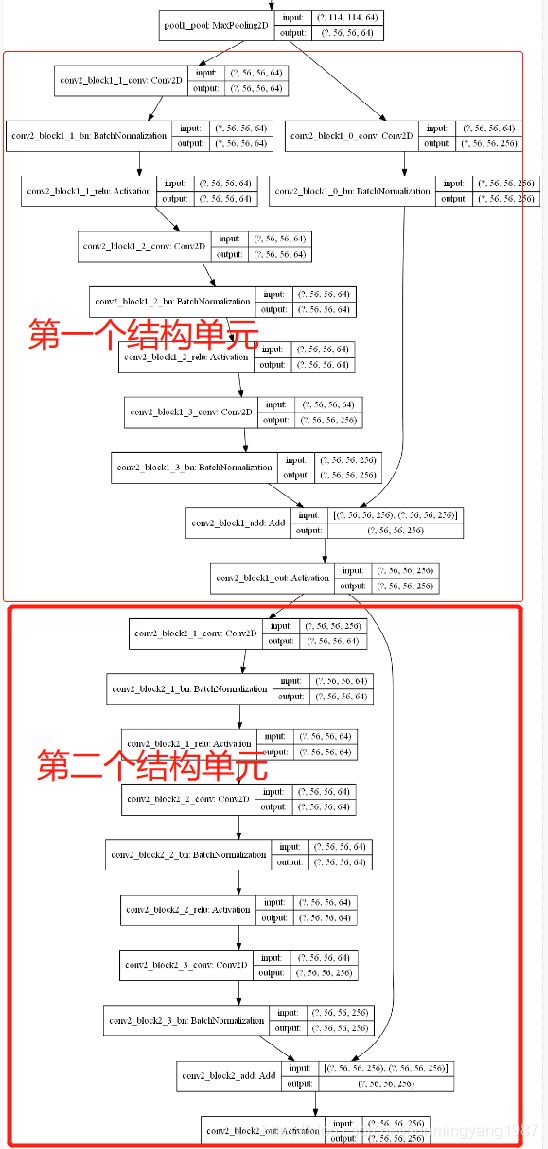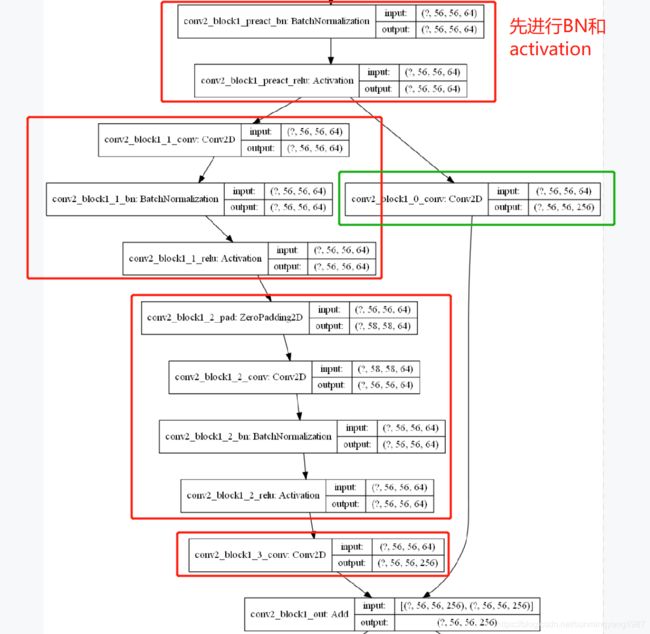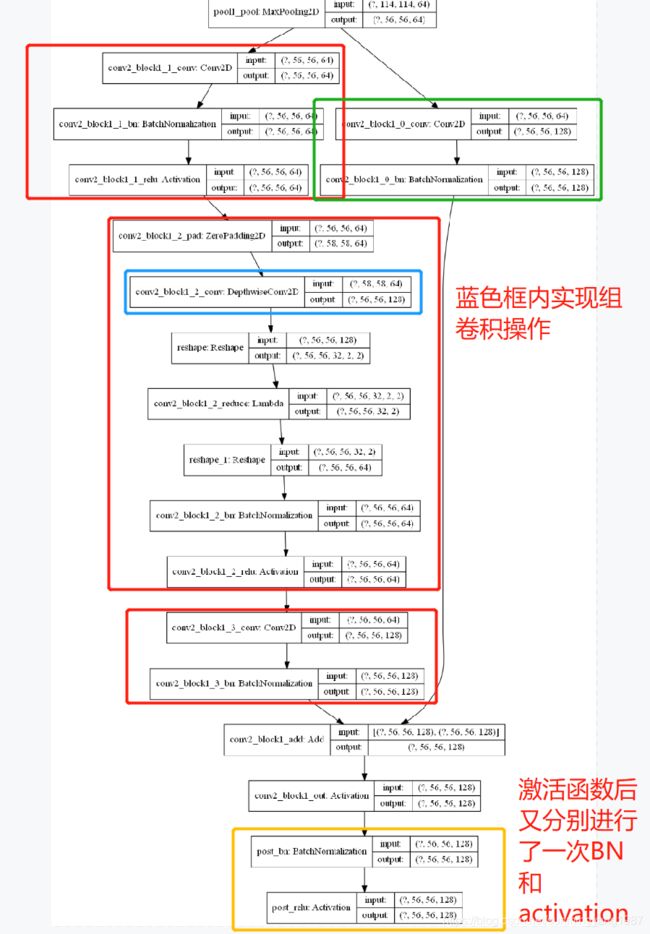tensorflow2.2中定义的ResNet和ResneXt中的bottleneck结构
目录
-
-
- 1、论文中提出的ResNet网络结构
- 2、tensorflow中的三种ResNet或ResNeXt结构单元
-
- 2.1、第一种结构单元
- 2.2 第二种结构单元
- 2.3 第三种结构单元
-
1、论文中提出的ResNet网络结构
tensorflow的Keras高级API中定义了50,101和152层的ResNet和ResNeXt,其中的bottlenect结构的实现在后面介绍。
ResNet论文中提出的50,101和152层结构如下图所示:

可以发现,ResNet网络结构中的五个stage分别将feature map尺寸减小一半,输入图片尺寸为224,conv5输出的feature map大小为224/2^5=7;50,101和152层的ResNet中相同stage对应的结构单元是相同的,不同的只是堆叠的次数;不同stage中的结构单元分为三个卷积层,其中前两个卷积的卷积核数相同,最后一个卷积层的卷积核数分别是前两个的4倍。
这种结构单元在原文中被称为bottleneck,bottleneck中包含的三个卷积分别为1x1,3x3和1x1,采用1x1卷积的好处有:
(1)与baseblock相比(如下图),bottleneck结构引入了两次ReLU,大大提高了网络结构的非线性;
(2)采用1*1卷积先降维再升维,大大减少了一个结构单元的计算量,提高了网络结构单位计算量的表现力,同时这种升维降维的过程实现了特征的跨通道线性组合,进一步提高了神经网络的整体表现力。
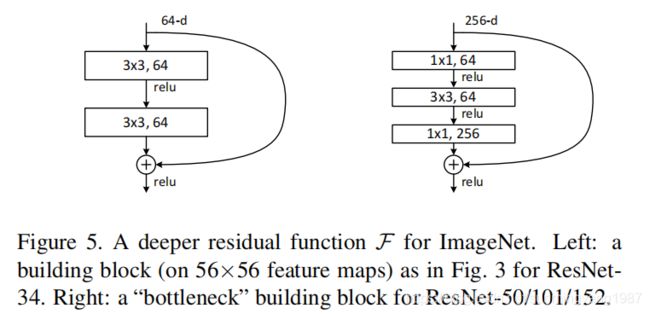
2、tensorflow中的三种ResNet或ResNeXt结构单元
tensorflow2.2官方代码中ResNet结构单元共有三种,其中第二种是每个stage前先进行BN和activation操作;第三种是ResNeXt网络所采用的的grouped conv。
2.1、第一种结构单元
ResNet中的第一种bottleneck结构单元,结构单元中含有三个卷积结构,每个卷积结构都包括CBR(conv+BN+ReLu),三个卷积结构中卷积操作的卷积核大小分别为11、33和1*1,官方实现代码:
def block1(x, filters, kernel_size=3, stride=1, conv_shortcut=True, name=None):
"""A residual block.
Arguments:
x: input tensor. x为输入张量,可以接上其它残差结构单元的输出。
filters: integer, filters of the bottleneck layer. #卷积核个数
kernel_size: default 3, kernel size of the bottleneck layer. #卷积核大小
stride: default 1, stride of the first layer. #卷积步长
conv_shortcut: default True, use convolution shortcut if True,
otherwise identity shortcut. #布尔型参数,利用该参数判断shortcut是否要进行conv下采样
name: string, block label. #结构单元名字
Returns:
Output tensor for the residual block. #该结构单元的输出
"""
bn_axis = 3 if backend.image_data_format() == 'channels_last' else 1 #根据数据格式是通道在前还是通道在后给bn_axis赋值
if conv_shortcut: #先计算shortcut,如果需要卷积下采样,则执行该分支来计算shortcut,shortcut的卷积层标记为该结构单元的第零层卷积:0_conv
shortcut = layers.Conv2D(
4 * filters, 1, strides=stride, name=name + '_0_conv')(x)
shortcut = layers.BatchNormalization(
axis=bn_axis, epsilon=1.001e-5, name=name + '_0_bn')(shortcut)
else:
shortcut = x #如果不需要卷积下采样,shortcut直接等于输入
#第一个卷积结构:
x = layers.Conv2D(filters, 1, strides=stride, name=name + '_1_conv')(x)
x = layers.BatchNormalization(
axis=bn_axis, epsilon=1.001e-5, name=name + '_1_bn')(x)
x = layers.Activation('relu', name=name + '_1_relu')(x)
#第二个卷积结构
x = layers.Conv2D(
filters, kernel_size, padding='SAME', name=name + '_2_conv')(x)
x = layers.BatchNormalization(
axis=bn_axis, epsilon=1.001e-5, name=name + '_2_bn')(x)
x = layers.Activation('relu', name=name + '_2_relu')(x)
#第三个卷积结构
x = layers.Conv2D(4 * filters, 1, name=name + '_3_conv')(x) #卷积核数为4 * filters,与shortcut的
x = layers.BatchNormalization(
axis=bn_axis, epsilon=1.001e-5, name=name + '_3_bn')(x)
x = layers.Add(name=name + '_add')([shortcut, x])
x = layers.Activation('relu', name=name + '_out')(x)#add之后再进行激活
return x
以上代码定义的残差单元如下图所示:
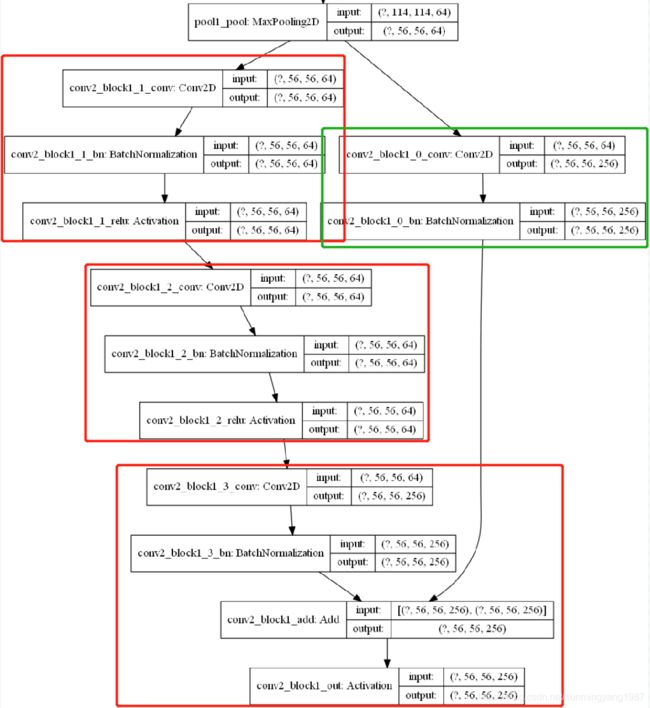
用以下代码定义上图所示网络结构的多个叠加,对于每个stage,含有如上图所示的多个结构单元,并且只有第一个结构单元的shortcut是采用conv下采样:
def stack1(x, filters, blocks, stride1=2, name=None):
"""A set of stacked residual blocks.
Arguments:
x: input tensor.
filters: integer, filters of the bottleneck layer in a block.
blocks: integer, blocks in the stacked blocks.
stride1: default 2, stride of the first layer in the first block.
name: string, stack label.
Returns:
Output tensor for the stacked blocks.
"""
x = block1(x, filters, stride=stride1, name=name + '_block1')
for i in range(2, blocks + 1):#当blocks为大于等于2的整数时,才进入for循环
x = block1(x, filters, conv_shortcut=False, name=name + '_block' + str(i))
return x
当blocks等于2时,得到的残差网络结构:
2.2 第二种结构单元
第二种ResNet结构单元定义代码如下所示:
def block2(x, filters, kernel_size=3, stride=1, conv_shortcut=False, name=None):
"""A residual block. 第二种结构单元的输入参数与第一种完全相同
Arguments:
x: input tensor.
filters: integer, filters of the bottleneck layer.
kernel_size: default 3, kernel size of the bottleneck layer.
stride: default 1, stride of the first layer.
conv_shortcut: default False, use convolution shortcut if True,
otherwise identity shortcut.
name: string, block label.
Returns:
Output tensor for the residual block.
"""
bn_axis = 3 if backend.image_data_format() == 'channels_last' else 1
preact = layers.BatchNormalization(
axis=bn_axis, epsilon=1.001e-5, name=name + '_preact_bn')(x)
preact = layers.Activation('relu', name=name + '_preact_relu')(preact)
if conv_shortcut:
shortcut = layers.Conv2D(
4 * filters, 1, strides=stride, name=name + '_0_conv')(preact)
else:
shortcut = layers.MaxPooling2D(1, strides=stride)(x) if stride > 1 else x#注意这里与第一种结构单元不同
#第一个卷积结构
x = layers.Conv2D(
filters, 1, strides=1, use_bias=False, name=name + '_1_conv')(preact)
x = layers.BatchNormalization(
axis=bn_axis, epsilon=1.001e-5, name=name + '_1_bn')(x)
x = layers.Activation('relu', name=name + '_1_relu')(x)
#第二个卷积结构
x = layers.ZeroPadding2D(padding=((1, 1), (1, 1)), name=name + '_2_pad')(x)
x = layers.Conv2D(
filters,
kernel_size,
strides=stride,
use_bias=False,
name=name + '_2_conv')(x)
x = layers.BatchNormalization(
axis=bn_axis, epsilon=1.001e-5, name=name + '_2_bn')(x)
x = layers.Activation('relu', name=name + '_2_relu')(x)
#第三个卷积结构
x = layers.Conv2D(4 * filters, 1, name=name + '_3_conv')(x)
x = layers.Add(name=name + '_out')([shortcut, x])
return x
2.3 第三种结构单元
定义代码如下:
def block3(x,
filters,
kernel_size=3,
stride=1,
groups=32,
conv_shortcut=True,
name=None):
"""A residual block.
Arguments:
x: input tensor.
filters: integer, filters of the bottleneck layer.
kernel_size: default 3, kernel size of the bottleneck layer.
stride: default 1, stride of the first layer.
groups: default 32, group size for grouped convolution. #该参数定义的卷积分组数量
conv_shortcut: default True, use convolution shortcut if True,
otherwise identity shortcut.
name: string, block label.
Returns:
Output tensor for the residual block.
"""
bn_axis = 3 if backend.image_data_format() == 'channels_last' else 1
if conv_shortcut:
shortcut = layers.Conv2D(
(64 // groups) * filters,
1,
strides=stride,
use_bias=False,
name=name + '_0_conv')(x)
shortcut = layers.BatchNormalization(
axis=bn_axis, epsilon=1.001e-5, name=name + '_0_bn')(shortcut)
else:
shortcut = x
x = layers.Conv2D(filters, 1, use_bias=False, name=name + '_1_conv')(x)
x = layers.BatchNormalization(
axis=bn_axis, epsilon=1.001e-5, name=name + '_1_bn')(x)
x = layers.Activation('relu', name=name + '_1_relu')(x)
c = filters // groups
x = layers.ZeroPadding2D(padding=((1, 1), (1, 1)), name=name + '_2_pad')(x)
x = layers.DepthwiseConv2D(
kernel_size,
strides=stride,
depth_multiplier=c,
use_bias=False,
name=name + '_2_conv')(x)
x_shape = backend.int_shape(x)[1:-1]
x = layers.Reshape(x_shape + (groups, c, c))(x)
x = layers.Lambda(
lambda x: sum(x[:, :, :, :, i] for i in range(c)),
name=name + '_2_reduce')(x)
x = layers.Reshape(x_shape + (filters,))(x)
x = layers.BatchNormalization(
axis=bn_axis, epsilon=1.001e-5, name=name + '_2_bn')(x)
x = layers.Activation('relu', name=name + '_2_relu')(x)
x = layers.Conv2D(
(64 // groups) * filters, 1, use_bias=False, name=name + '_3_conv')(x)
x = layers.BatchNormalization(
axis=bn_axis, epsilon=1.001e-5, name=name + '_3_bn')(x)
x = layers.Add(name=name + '_add')([shortcut, x])
x = layers.Activation('relu', name=name + '_out')(x)
return x
以上代码定义的网络结构如下图所示:
